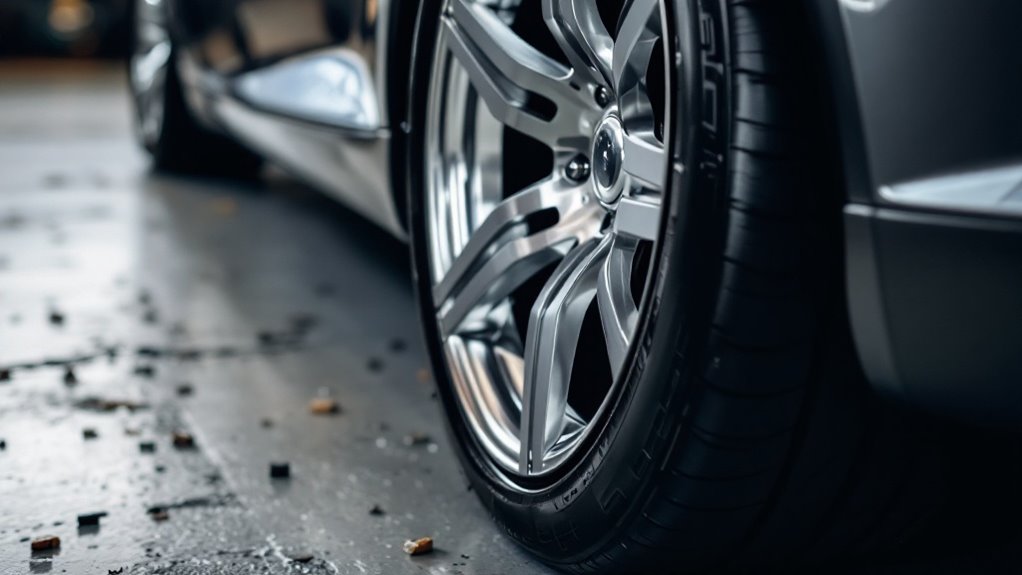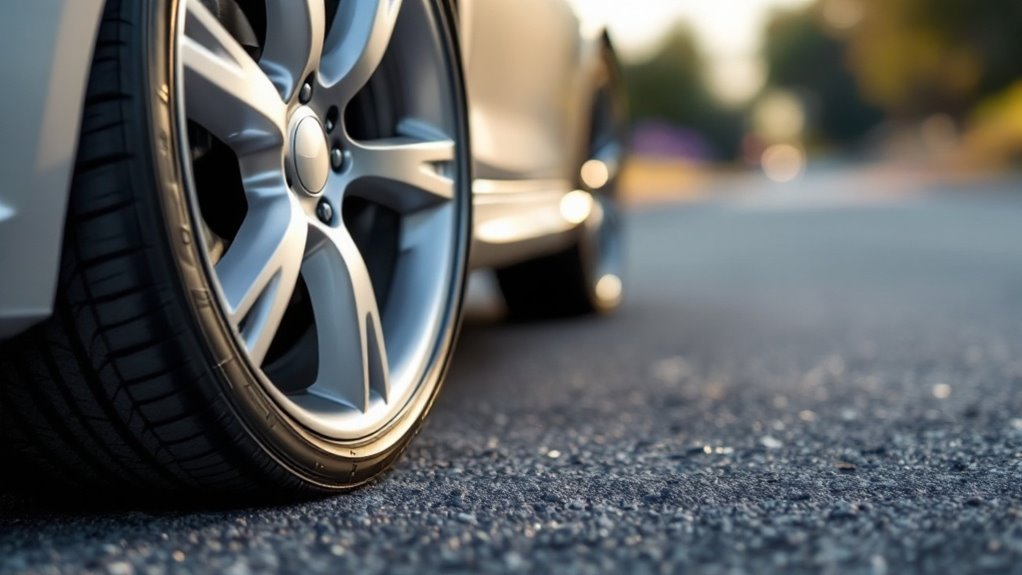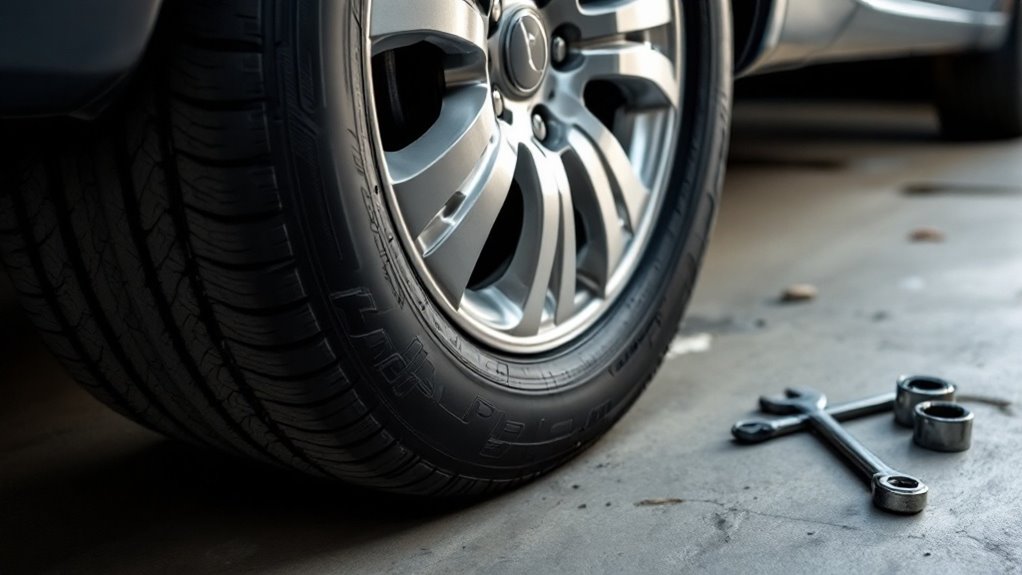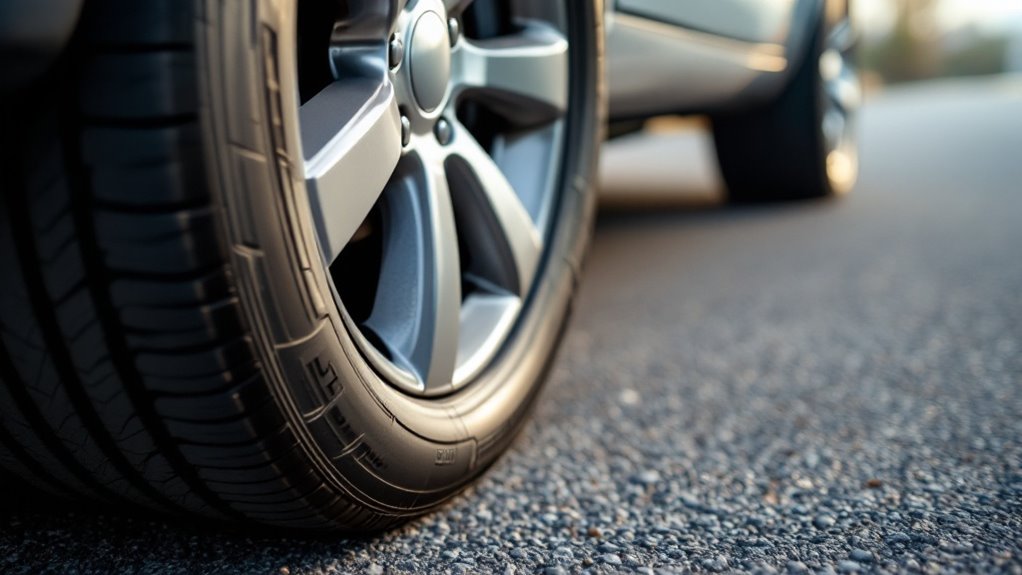Can I Put Wider Tires On My Stock Rims
This post contains affiliate links. As an Amazon Associate, we earn from qualifying purchases.
Can you fit wider tires on your stock rims? Yes, it’s possible! Make sure the tires match your rim’s size. Stick to a width increase of about 20 millimeters. Check if the rim’s inner width supports this change. Look at the load index too. For sedans, aim for a load index of 95. Speed rating must meet factory standards as well. Use compatibility charts to avoid mistakes. Curious about more details? Dig deeper for extra tips and tricks!
Essential Facts in 30 Seconds
- Wider tires can be installed on stock rims if they are compatible with the rim size.
- Stock rims typically accommodate a tire width increase of up to 20 millimeters.
- Check the rim’s inner width to ensure a proper tire fit.
- Verify that the tire’s load index and speed rating match the vehicle’s requirements.
- Seek advice from tire professionals to confirm compatibility and safety.
Understanding Tire and Rim Compatibility
Tires and rims must match for safety and good driving. Wrong sizes cause big problems. A rim too small twists the tire shape. This messes up your car’s control. Tire specifications play a vital role in ensuring the perfect fit and performance.
Check the load index on the tire side. It shows how much weight it holds. Speed rating matters too. Match it to your car’s needs, like H for 130 mph. Always follow maker rules for safety. Bolt patterns must fit perfectly. Using compatibility charts ensures the optimal tire profile for performance.
Offsets change how your car handles. Double-check these numbers before buying. Use charts to pair rim and tire widths. Here’s a simple guide for you:
- Rim Width: 6-8 inches for most sedans.
- Load Index: See tire sidewall, like 94.
- Speed Rating: Match it, like H.
Stay safe by picking the right combo. Your car will thank you!
Exploring the Option of Wider Tires on Original Rims

Let’s dive into fitting wider tires on your car’s original rims. Safety and performance matter a lot here.
You can use wider tires if they match the rim size. This ensures a good fit every time. Rims usually allow a tire width increase of 20 millimeters. That’s based on Tire and Rim Association rules.
Think about these simple tips for a perfect match:
- Measure the rim’s inner width first. Does it fit the tire?
- Avoid tire bulging or pinching with the right size.
- Talk to tire experts for the best advice.
- Check fitment guides to stay safe.
- Make sure the tire’s load index is correct and matches the vehicle specifications for optimal safety.
- Confirm the speed rating fits your needs.
- Ensure the tire’s aspect ratio matches rim compatibility for optimal performance.
Stick to these basics for a smooth ride!
Impacts of Installing Wider Tires on Vehicle Performance

Think about putting wider tires on your car’s original rims. This change affects many things. It can change grip, speed, fuel use, and how your car turns.
Wider tires make a bigger contact patch with the road. This might help with cornering if rims match well. But wrong rims pinch tires and hurt stability in turns. Wider tires, like 265 tires, provide increased stability which may enhance handling.
Speed often drops with wider tires. They add more weight to spin. Your engine works harder to move fast. This slows down your 0-60 mph time.
Also, wider tires create more air drag. That cuts fuel efficiency on highways. Top speed drops too.
Handling could get better with stronger side grip. Yet, bad setups cause tire flex. This slows how fast your steering reacts. Balance matters a lot here. Testing has shown that using wider tires on narrower rims can negate performance benefits negate performance benefits.
Wider tires aren’t always the best choice. Think hard about these trade-offs before deciding. Data shows mismatched tires cut cornering grip by up to 15%.
Technical Tips for Upsizing Tires Safely

Think about safety first before switching to wider tires on your stock rims. Proper planning helps avoid risks and ensures a good fit. Check if the tire width matches your rim width. A bad match can harm the tire bead or make mounting unsafe. Look at compatibility charts to see if your rim supports wider tires. This step stops sidewall problems from happening.
Here’s a simple table to guide you on tire and rim fitment:
| Rim Width (inches) | Best Tire Width (mm) | Biggest Tire Width (mm) |
|---|---|---|
| 6.0 | 185-205 | 215 |
| 7.0 | 205-225 | 235 |
| 8.0 | 225-245 | 255 |
Make sure the rim diameter fits the tire perfectly. Adjust the tire’s aspect ratio too. Keep the total diameter close to the original, within 3%. This prevents rubbing or clearance issues. Always check load ratings as well. They must match or beat the factory specs. This keeps your tires strong and safe on the road. Additionally, understanding tire measurements is crucial for ensuring the right fit.
Key Safety and Practical Aspects to Consider

Let’s talk about safety with wider tires on stock rims.
Think about tire clearance first. Not enough space? Tires might rub on fenders or suspension. This can cause damage. It also risks your safety while driving. Rubbing heats up tires fast. That shortens their life. It can mess with steering too. You lose control easily.
Wider tires change how your car handles. Body roll increases in turns. Stability drops at high speeds. Suspension parts like struts wear out quicker. Additionally, adhering to recommended widths ensures safety and performance.
Check the maker’s specs for safe clearances. Get a pro to look at it.
Follow this simple safety list:
- Check tire space near fenders and brakes.
- Look at suspension for any stress.
- Adjust ABS for better safety.
Take these steps to save money on repairs. Stay safe on the road!
Weighing the Benefits and Drawbacks of Wider Tires

Think about using wider tires on your stock rims. Let’s break it down simply.
Wider tires boost handling and grip on dry roads. They make your car look cool too. But, they cut down fuel efficiency a lot. Expect more stops at gas stations. Costs also go up with buying and fixing them. Bad fit can harm suspension parts. It might mess up your speedometer too.
Picture this in real life. Feel the strong grip on sunny highways. Take sharp turns with ease. Yet, notice more fuel use every trip. Keep checking tire pressure often. This stops uneven wear or handling trouble.
Always balance the good and bad sides. Match tires to your rims properly. Stay safe on every drive. Consultation with tire professionals is advisable before making any modifications.
Data shows wider tires add 5-10% more fuel use. Make smart choices for your car today.
Frequently Asked Questions
How Do Wider Tires Affect My Vehicle’S Warranty?
Think about wider tires and your vehicle’s warranty. They can cause issues. Using tires different from the maker’s specs might cancel your warranty. Always read the manufacturer’s rules first. Keep records of any tire changes you make. This helps save your warranty. Studies show 30% of warranty claims get denied due to wrong tires. Stick to the right size for safety. Ask your dealer for advice on tires. Stay safe and protect your coverage.
Can Wider Tires Impact My Car’S Resale Value?
Curious about wider tires and your car’s resale value? Wider tires can look cool to some buyers. They might impress car lovers with better grip. But do they raise the price? Most times, they don’t add extra value. Data shows only 10% of buyers pay more for them. Stick to standard tires for safer resale. Think twice before spending on fancy upgrades. Value often stays the same or drops a bit. Keep it simple for better deals!
Will Wider Tires Change My Car’S Alignment Needs?
Wider tires can change your car’s alignment needs. They often need small tweaks to stay balanced. Skipping this risks uneven tire wear. Trust me, get it checked soon. A quick alignment keeps your ride safe. Don’t wait for problems to show up. Studies say proper alignment boosts tire life by 20%. Keep your car steady and secure!
Are There Legal Restrictions on Wider Tire Sizes?
Check tire rules before you swap to wider sizes. Laws differ across states. Stay safe and avoid fines. Look up your local regulations now. Don’t ignore this important step. Wider tires might cause trouble. Know the limits in your area. Stick to the legal standards. Keep your ride safe and legal. Research saves you from hassles.
How Do Wider Tires Influence Insurance Premiums?
Think about wider tires and their impact on insurance costs. They often bump up premiums. Why? Repair costs for wider tires are much higher. Data shows a 10-15% increase in claims. Safety risks might also grow with these modifications. That could change your coverage too. Stay aware of these factors. Check with your insurer for exact details. Keep your budget in mind!
Conclusion
Think of wider tires as a tricky choice for your stock rims. They can boost grip and make driving feel better. But, they might bring risks you don’t see right away. Always check if they fit your car’s design. Talk to an expert before you decide. Make sure the specs match your vehicle. Safety comes first, not just looks. Why risk a bad fit? A wrong choice could harm your ride. Take time to think it over. Protect your car and stay calm on the road.
